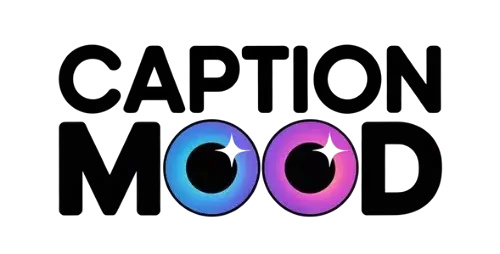Ever wondered what does closed captions mean when watching your favorite show or YouTube video? Closed captions are on-screen text that display dialogue, sounds, and background audio, making content accessible for everyone especially the hearing impaired. In today’s digital world, understanding the meaning of closed captions is essential for inclusive communication across platforms like Netflix, TV, and social media.
What Is Closed Captioning?
Closed captioning is the process of displaying text on a screen that represents the spoken words, sound effects, and background noises in a video. In simple terms, it’s a visual version of the audio helping people understand the content even when they can’t hear it.
It was first introduced to make television accessible for people with hearing loss, but today it’s widely used on YouTube, Netflix, and streaming apps. Closed captions not only promote accessibility and inclusivity, but also improve understanding in noisy environments or when you’re learning a new language.
Here’s a quick look at how captions help different viewers:
| Viewer Type | Benefit of Closed Captioning |
| Hearing Impaired | Access full dialogue and sound details |
| Language Learners | Understand pronunciation and context |
| Viewers in Noisy Areas | Follow along without missing words |
| SEO & Creators | Improve engagement and video reach |
In short, closed captioning means transforming audio into readable text — a small feature that makes a huge difference in global communication.
What Does Closed Captions Mean at AMC?
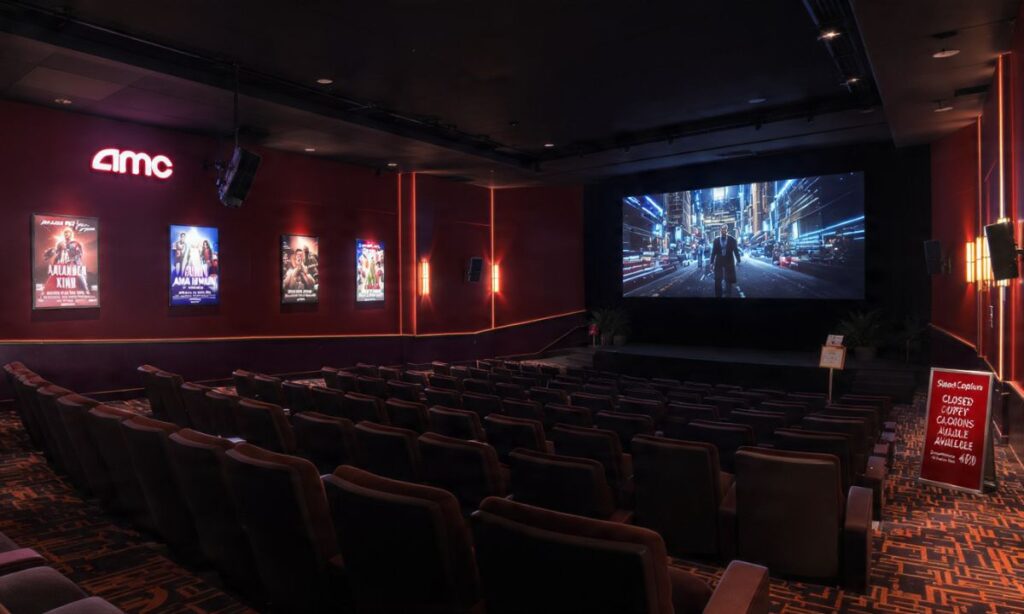
When you visit your local AMC theater, you might notice special devices or glasses available at the counter. These are closed caption devices, and they’re changing how people experience movies in theaters.
At AMC, closed captions refer to assistive technology that displays text on a personal screen or glasses. Unlike open captions that appear on the main screen for everyone, AMC’s closed caption devices give you a private viewing experience. You can read dialogue, sound effects, and speaker identification without affecting other moviegoers.
Types of AMC Closed Caption Devices
AMC offers several options for accessible viewing:
CaptiView Device: This is a flexible gooseneck display that fits into your cup holder. The screen shows synchronized captions that only you can see. You can adjust the brightness, position, and angle to match your preference.
Sony Glasses: These smart glasses display captions directly in your line of vision. The text appears to float in front of the movie screen, creating a seamless viewing experience.
Rear Window Captioning: This system uses a reflective panel that sits in your cup holder. Captions are displayed on an LED screen at the back of the theater, and you see them reflected in your personal mirror.
To use these devices, simply request them at the box office or guest services desk. The staff will show you how to sync the device with your specific movie showtime. Best of all, this service is completely free for anyone who needs or wants it.
What Does Closed Captions Mean Subtitles?
This is where many people get confused. While closed captions and subtitles might look similar, they serve different purposes and contain different information.
Key Differences Between Closed Captions and Subtitles
FeatureClosed CaptionsSubtitlesPrimary AudienceDeaf and hard of hearing viewersViewers who can hear but need translationLanguageSame as audio languageOften translated to different languagesSound EffectsYes, includes [music playing], [door slams]Usually no sound descriptionsSpeaker IdentificationShows who is speakingTypically not includedToggling OptionCan be turned on/offCan be turned on/offPurposeAccessibility and comprehensionTranslation and comprehension
Closed captions provide a complete text representation of everything happening in the audio. This includes dialogue, background noises, music cues, and even emotional tones. For example, you might see “[suspenseful music intensifies]” or “[whispers]” in closed captions.
Subtitles focus primarily on translating spoken dialogue. They assume you can hear the soundtrack, background music, and sound effects. Subtitles help you understand what’s being said when content is in a foreign language.
When to Use Closed Captions vs Subtitles
Choose closed captions when you need complete audio accessibility, want to watch videos in noisy environments, are learning a language and want full context, or prefer reading along with dialogue for better comprehension.
Choose subtitles when you’re watching foreign language content, can hear the audio but want translation, or prefer minimal on-screen text.
What is Closed Caption in Facebook?
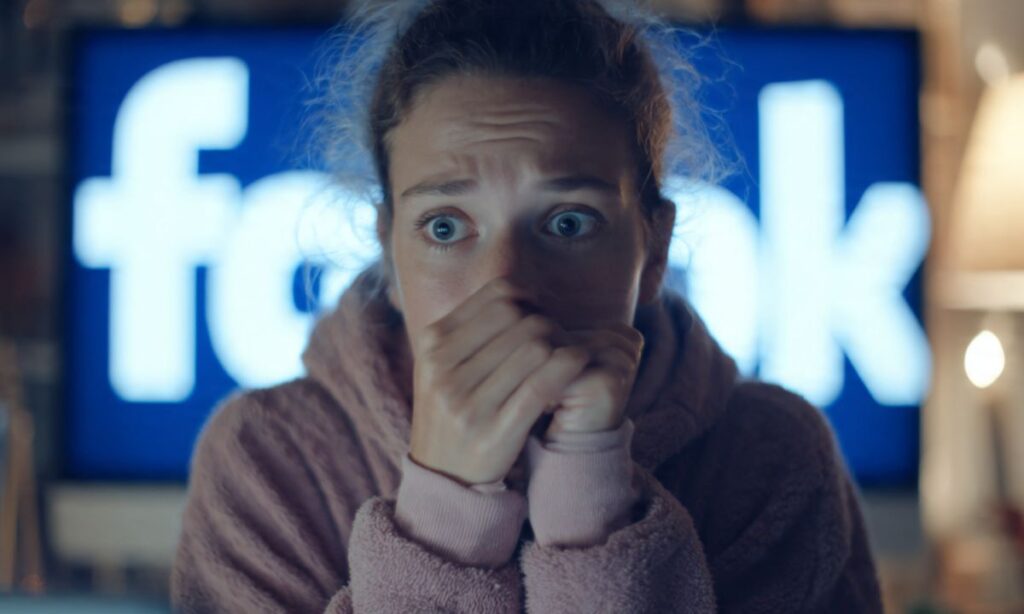
Facebook has made significant strides in making video content accessible to everyone. Understanding how closed captions work on this platform helps you create better content and enjoy videos more fully.
Closed captions on Facebook are text overlays that display spoken words and audio descriptions in videos. Facebook supports both automatic captions generated by artificial intelligence and custom captions uploaded by content creators.
How Facebook Closed Captions Work
When you upload a video to Facebook, the platform automatically generates captions using speech recognition technology. These auto-generated captions analyze the audio track and convert speech into text. While convenient, automatic captions aren’t always accurate, especially with:
- Accents and dialects
- Technical terminology
- Multiple speakers talking simultaneously
- Background noise interference
- Fast-paced dialogue
For viewers, accessing closed captions on Facebook is straightforward. When watching a video, look for the “CC” button in the bottom right corner of the video player. Tap or click this button to toggle captions on or off. On mobile devices, captions might appear automatically if you’re watching with sound muted.
Creating Better Captions for Your Facebook Videos
If you’re a content creator, taking control of your captions improves accessibility and engagement. Facebook allows you to edit auto-generated captions or upload your own SRT (SubRip Subtitle) files.
High-quality Facebook captions should include accurate transcription of all speech, proper punctuation and grammar, speaker identification when multiple people talk, sound effect descriptions in brackets, and proper timing synchronized with audio.
Videos with captions perform better on Facebook because 85% of Facebook videos are watched without sound, captions make content accessible to deaf and hard of hearing users, search engines can index caption text for better discoverability, and viewers are more likely to watch captioned videos to completion.
What Does Closed Captions Mean on Instagram?
Instagram has evolved from a simple photo-sharing app to a comprehensive video platform. Closed captions have become essential for reaching wider audiences on this visual-first platform.
Closed captions on Instagram are text overlays that transcribe speech and audio elements in your Stories, Reels, and feed videos. Instagram offers automatic captioning tools and options to customize how captions appear.
Instagram’s Auto-Captioning Feature
Instagram introduced automatic captions for Stories and Reels, making content creation faster and more accessible. When you record or upload a video, Instagram’s AI analyzes the audio and generates captions automatically.
To add auto-captions to your Instagram content, record or upload your video to Stories or Reels, tap the sticker icon at the top of the screen, select the “Captions” sticker, and Instagram will transcribe your audio automatically. You can then edit the text, change colors, adjust fonts, and reposition captions anywhere on screen.
Why Instagram Captions Matter for Engagement
The Instagram algorithm favors content that keeps viewers watching. Captions directly impact your video performance in several ways.
Increased watch time: Viewers are 12% more likely to finish watching videos with captions. When people can follow along with text, they stay engaged even in sound-off environments.
Broader accessibility: Captions make your content available to deaf and hard of hearing users, non-native speakers, and people in noise-sensitive situations like offices or public transportation.
Better discoverability: Instagram can’t “listen” to your videos, but it can read caption text. Properly captioned videos have better chances of appearing in search results and on Explore pages.
Best Practices for Instagram Captions
Create professional-looking captions by keeping text short and readable (3-4 words per line maximum), using high-contrast colors so text stands out against backgrounds, positioning captions where they don’t cover important visual elements, proofreading auto-generated captions for accuracy, and adding relevant keywords naturally for SEO benefits.
For Instagram Reels specifically, captions are crucial because most users scroll through Reels quickly. Eye-catching captions grab attention within the first second and convince viewers to keep watching.
What Is Closed Captioning vs Subtitles
Many people use “closed captions” and “subtitles” interchangeably, but they’re not exactly the same. Think of it this way:
- Subtitles show only the spoken dialogue, mainly for viewers who can hear but need translation.
- Closed captions (CC) include dialogue and sound effects, like [music], [laughter], or [door creaks], designed for those who can’t hear the audio at all.
Here’s a quick comparison to make it clear:
| Feature | Closed Captions (CC) | Subtitles |
| Includes sound effects | ✅ Yes | ❌ No |
| Shows speaker names | ✅ Yes | ❌ No |
| Used for hearing impaired | ✅ Yes | ⚪ Sometimes |
| Translation for foreign language | ⚪ Sometimes | ✅ Yes |
| Toggle On/Off | ✅ Yes | ✅ Yes |
In short, closed captioning adds context, while subtitles translate language. Both serve communication, but captions make content more inclusive and accessible for everyone.
What Does Closed Caption Mean on TV
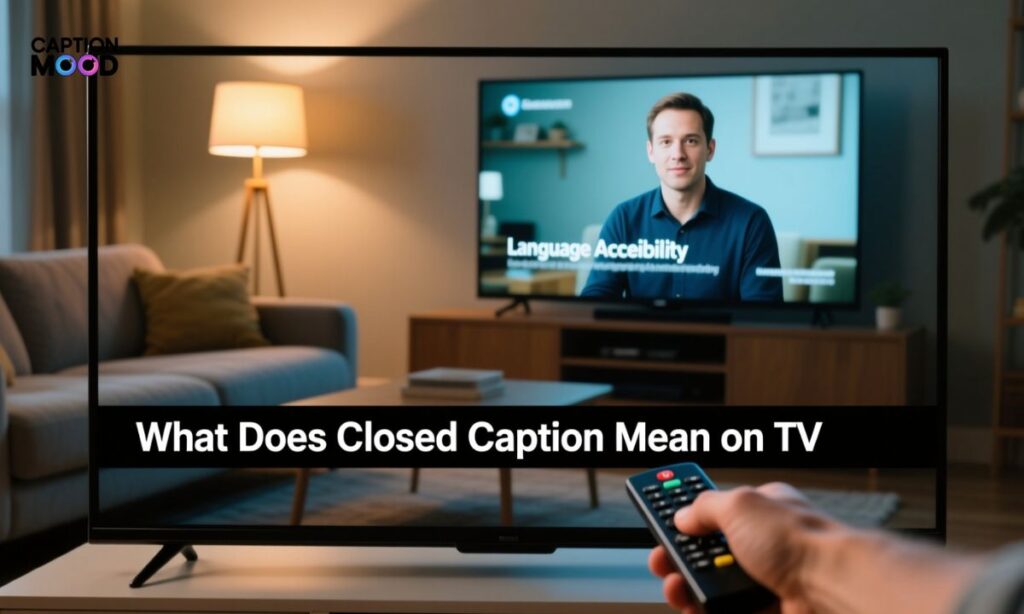
When you see “CC” or “Closed Caption” on your TV screen, it means your TV can display written text that matches what’s being said in real time. It’s a built-in accessibility feature found in most modern TVs and streaming services.
For example, when you enable closed captioning on your TV:
- Every line of dialogue appears as text.
- You can see background noises like [applause] or [door slams].
- It helps when watching content in a different accent or low volume.
This is especially useful for older audiences, language learners, or anyone watching in a noisy environment. Whether you’re watching Netflix, Hulu, or cable TV, enabling closed captions makes your viewing experience more interactive and inclusive.
What Does Closed Caption Mean AMC
If you’ve seen the “CC” label while watching AMC (American Movie Classics), it means that the channel provides closed captioning for all its movies and shows. AMC includes captions to ensure everyone can enjoy their classic and modern films equally — even those who are hard of hearing.
Closed captions on AMC usually include:
- Complete dialogue text
- Background music descriptions
- Sound effects like gunshots or laughter
- Speaker identification when multiple voices are present
You can enable closed captions on AMC via your remote control’s “CC” button or through your streaming app’s settings.
AMC’s use of closed captioning technology reflects a growing commitment to accessibility and viewer experience, ensuring no one misses the story, emotion, or humor of their favorite films.
What Does Closed Caption Mean in Theaters
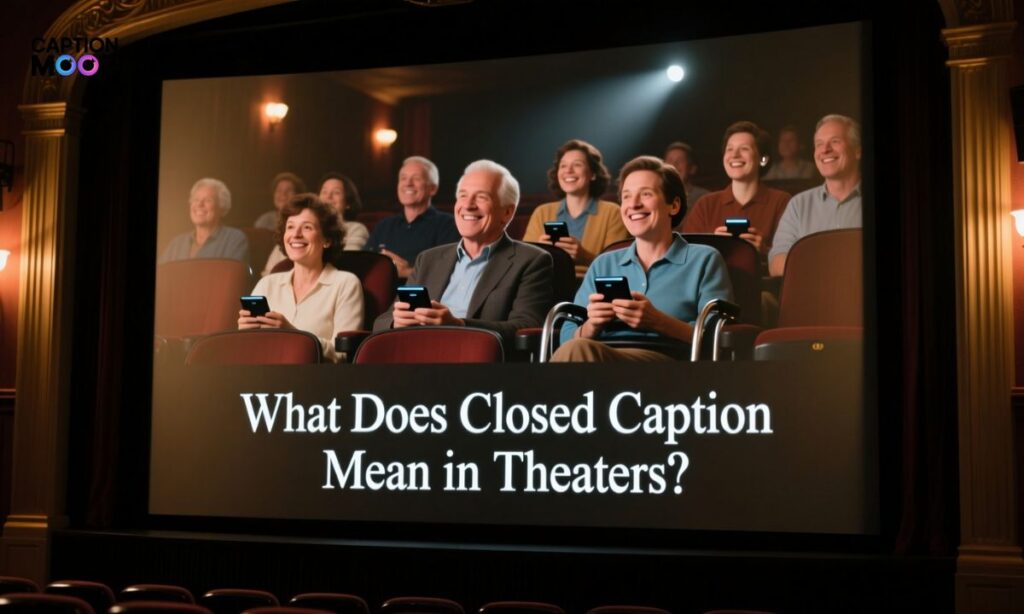
In movie theaters, closed captioning means showing text of dialogue and sounds for people who are deaf or hard of hearing — but not on the main screen. Instead, captions are displayed using personal captioning devices, like small screens attached to your seat or special glasses.
These captions include every word spoken, along with sound cues like [music playing] or [crowd cheering], giving the viewer a full experience of the movie.
Closed captions in theaters make entertainment more inclusive and accessible, following ADA (Americans with Disabilities Act) requirements. Many cinema chains like AMC, Regal, and Cinemark now offer these assistive devices upon request, ensuring everyone enjoys the movie equally.
| Theater Feature | What It Does |
| Captioning Device | Displays live captions privately |
| Assistive Listening | Boosts sound for hard-of-hearing users |
| Open Captions Show | Shows text on the big screen for all viewers |
So, when you ask for closed captioning in a theater, you’re asking for a personal display of the film’s text and sounds, not subtitles on the big screen.
Why Is It Called Closed Captioning
It’s called “closed” captioning because the captions are not visible until you turn them on. The word “closed” means they can be enabled or disabled by the viewer — unlike open captions, which are permanently visible on screen.
The term originated in the 1970s when TV technology first allowed viewers to control captions through a “decoder” or a settings option. This flexibility made television more accessible while keeping the screen uncluttered for those who didn’t need captions.
So, “closed” = optional visibility, and “captioning” = on-screen text of audio — together forming the phrase closed captioning.
This feature now extends beyond TV to YouTube, Netflix, and streaming platforms, making content both user-friendly and inclusive.
Subtitles vs Closed Captions on Netflix
When watching Netflix, you’ll notice two options Subtitles and Closed Captions (CC). While both display text, they serve slightly different audiences.
- Subtitles translate dialogue for viewers who can hear but need another language.
- Closed captions show everything: dialogue, background sounds, music, and speaker labels.
For example, a Netflix show might display:
- Subtitle: “Let’s go to the park.”
- Closed Caption: [Birds chirping] [Anna]: Let’s go to the park.
| Feature | Subtitles | Closed Captions |
| Dialogue Display | ✅ Yes | ✅ Yes |
| Sound Effects | ❌ No | ✅ Yes |
| Speaker Names | ❌ No | ✅ Yes |
| Translations | ✅ Yes | ⚪ Sometimes |
| Accessibility | ⚪ Limited | ✅ Full |
Netflix allows you to choose either option from the Audio & Subtitles menu, ensuring your viewing experience matches your needs. For accessibility or noisy environments, closed captions are always the better choice.
Closed Caption Settings
Turning on closed caption settings is quick and customizable across different devices like TVs, Netflix, YouTube, and mobile apps. Here’s how you can access them:
| Platform | Steps to Enable Closed Captions |
| Smart TV | Go to Settings → Accessibility → Captions |
| Netflix | Select Audio & Subtitles → English [CC] |
| YouTube | Tap the CC icon on the video player |
| Mobile Apps | Look under Accessibility → Captions & Subtitles |
You can also customize the font style, color, size, and background opacity to make captions easier to read.
Closed caption settings are more than just a feature — they’re an accessibility tool that empowers every viewer to enjoy videos comfortably, regardless of sound or hearing ability.
What Does English CC Mean on Netflix
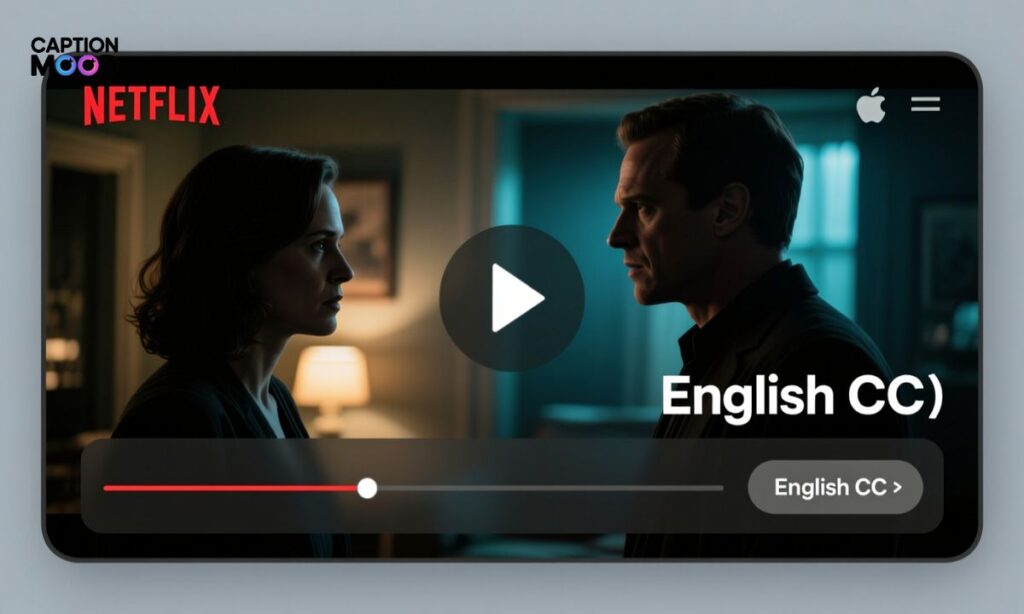
When you see “English [CC]” on Netflix, it means English Closed Captions. Unlike regular subtitles, these captions include not just spoken words but also sound effects, speaker names, and background noises like [phone ringing] or [door creaks].
This makes English CC ideal for:
- Viewers who are deaf or hard of hearing
- Those watching in a noisy place
- Anyone wanting to better understand accents or dialogue
So, when you select English [CC] on Netflix, you’re getting complete audio information in text form — every sound that adds meaning to the story.
What Does Closed Caption Mean in a Movie Theater
In movie theaters, closed captioning means personal on-screen text showing dialogue and sounds, available only to the viewer using assistive devices. Unlike open captions (visible to everyone), closed captions appear privately on a small screen or special glasses you borrow from the theater.
These captions show:
- Spoken lines
- Sound cues like [applause] or [explosion]
- Music notes and speaker tags
Most major cinema chains like AMC, Regal, and Cinemark provide these caption devices for free. This ensures equal movie access for people with hearing loss while keeping the big screen experience the same for everyone
Closed Captioning Examples
Here are some real-life examples of how closed captions appear in videos or on TV screens:
| Audio | Closed Caption Example |
| Background music starts | [Soft piano music playing] |
| Character laughs | [John laughs] |
| Phone rings | [Phone ringing] |
| Explosion sound | [Explosion in distance] |
| Dialogue | Sarah: Let’s go now! |
These examples show that closed captions are not just words, but also sound descriptions that help recreate the full experience for viewers who can’t hear the audio.
They’re essential for accessibility and also help people learn pronunciation, accents, and context when watching content in a foreign language.
Closed Captions YouTube
YouTube was one of the first major platforms to offer auto-generated closed captions using speech recognition technology. When you turn on captions (by clicking the CC icon), YouTube displays the dialogue as text on-screen — often automatically generated in multiple languages.
You can also:
- Upload your own caption file for accuracy
- Edit auto-captions to fix errors
- Translate captions into other languages for global audiences
Creators benefit too — YouTube captions improve SEO ranking, watch time, and accessibility. That’s why enabling closed captions on YouTube videos is considered a best practice for every content creator today.
Origin of Closed Captions
The concept of closed captioning originated in the 1970s as a solution for the hearing-impaired community to enjoy television equally. The first official closed-caption broadcast appeared in 1980, when networks like PBS began adding optional caption text using a special decoder.
Here’s a short timeline of its evolution:
| Year | Milestone |
| 1970s | Caption technology first introduced |
| 1980 | First official closed-captioned TV show aired |
| 1993 | FCC required captioning on new TVs in the U.S. |
| 2000s | Streaming platforms adopted closed captions |
| 2010s+ | Auto-captions and AI-based subtitles launched |
Today, closed captions are standard across all digital content, from broadcast TV to Netflix, YouTube, and TikTok — turning entertainment into an inclusive experience for everyone.
Closed Captioning Terminology
Before diving deeper, let’s understand the common terminology used in closed captioning. Knowing these terms helps you easily navigate caption settings or accessibility tools.
| Term | Meaning |
| Closed Captions (CC) | On-screen text of dialogue and sounds that can be turned on/off |
| Open Captions (OC) | Captions always visible on the screen; cannot be turned off |
| Subtitles | Text of spoken dialogue, usually for translation |
| Transcript | Full written version of the audio (not synced to video) |
| Live Captioning | Real-time captions generated during a live broadcast |
| Pre-recorded Captioning | Captions created manually for recorded content |
| SDH (Subtitles for Deaf and Hard of Hearing) | Combines captions and sound descriptions for accessibility |
Understanding these terms ensures you can choose the right caption format for every viewing situation — whether watching Netflix, YouTube, or live television.
Captions vs. Transcripts
At first glance, captions and transcripts may seem identical — both present spoken words in text form. But there’s a key difference:
- Captions are time-synced with the video.
- Transcripts are text-only documents listing everything said, without timestamps.
| Feature | Captions | Transcripts |
| Time-synced with video | ✅ Yes | ❌ No |
| Includes sound effects | ✅ Yes | ⚪ Sometimes |
| Shows speaker labels | ✅ Yes | ⚪ Sometimes |
| Used for accessibility | ✅ Yes | ⚪ Sometimes |
| Used for SEO & text reference | ⚪ Sometimes | ✅ Yes |
Captions enhance real-time understanding, while transcripts support content review, SEO, and accessibility documents. Many creators use both for better viewer engagement.
Closed Captions vs. Open Captions
The main difference between closed captions and open captions is control.
- Closed captions (CC): Can be turned on or off by the viewer.
- Open captions (OC): Are always visible on the video — no button needed.
| Feature | Closed Captions | Open Captions |
| Can be turned off | ✅ Yes | ❌ No |
| User control | ✅ Yes | ❌ No |
| Always visible | ❌ No | ✅ Yes |
| Used on TV & streaming | ✅ Yes | ⚪ Sometimes |
| Embedded in video | ❌ No | ✅ Yes |
Open captions are often used for social media videos or cinemas, where not every device supports CC settings. Closed captions remain the universal standard due to flexibility.
Pre-Recorded vs. Live Captions
Captions come in two main types — pre-recorded and live. Both serve accessibility but differ in creation and use.
| Type | Description | Best Used For |
| Pre-recorded Captions | Manually created, accurate, and synced perfectly | Movies, TV shows, YouTube videos |
| Live Captions | Generated in real-time using AI or human stenographers | News broadcasts, webinars, live streams |
Pre-recorded captions are more accurate and detailed, while live captions focus on speed and accessibility. Platforms like Zoom, Google Meet, and TV networks use live captioning for instant understanding.
Closed Captions vs. Subtitles
The terms are often mixed up, but here’s the key distinction:
- Subtitles: Show only spoken dialogue — ideal for translation or clarity.
- Closed captions: Include dialogue, background sounds, music, and tone cues.
| Aspect | Closed Captions (CC) | Subtitles |
| Shows sound effects | ✅ Yes | ❌ No |
| Speaker identification | ✅ Yes | ❌ No |
| Designed for hearing impaired | ✅ Yes | ⚪ Sometimes |
| Translation use | ⚪ Sometimes | ✅ Yes |
| Accessibility purpose | ✅ Yes | ⚪ Limited |
Simply put: subtitles translate words, while closed captions translate the entire sound experience.
Closed Caption Formats
Closed captions come in several technical formats depending on the platform or device. Each format carries data on timing, text, and sound cues.
| Format | Used By / Platform | Description |
| .SRT (SubRip) | YouTube, VLC, Netflix | Simple and widely compatible |
| .VTT (WebVTT) | Web & HTML5 videos | Supports styling and positioning |
| .SCC (Scenarist) | Broadcast TV | Professional, time-coded captions |
| .DFXP / TTML | Online streaming | XML-based, flexible format |
| .SMI / SAMI | Windows Media Player | Legacy format, still supported |
Choosing the right format ensures smooth playback, timing accuracy, and accessibility compliance across all platforms.
What Are Closed Captions?
Closed captions are textual representations of audio in a video — including speech, music, and background sounds. They make content understandable to those who cannot hear or prefer reading along.
In short, closed captions turn sound into text — letting you read the movie, not just watch it. They are vital for accessibility, language learning, and user engagement across all digital platforms.
Advantages of Closed Captions
Closed captions offer multiple benefits for both viewers and content creators:
- Improve accessibility for the deaf and hard of hearing
- Enhance comprehension in noisy environments
- Help language learners understand pronunciation
- Boost SEO ranking and video discoverability
- Increase audience retention and engagement
- Provide clarity for accent-heavy content
- Enable silent viewing on social media
- Help students take notes from video lectures
- Comply with legal accessibility standards (ADA, FCC)
Whether you’re a content creator or viewer, closed captions make video content smarter, inclusive, and easier to follow.
Examples of Closed Captions
Here are a few examples showing how captions appear during video playback:
| Audio Scene | Caption Example |
| Music starts | [Soft guitar music playing] |
| Laughter heard | [Audience laughs] |
| Character speaks | Emma: Are you coming? |
| Door slams | [Door slams loudly] |
| Background noise | [Rain falling outside] |
These examples highlight that closed captions capture both emotion and sound, giving a complete experience — not just text.
Closed Captions vs Subtitles: What’s the Difference?
Although closed captions and subtitles often look similar, their purpose is quite different.
- Closed captions are designed for people who cannot hear the audio.
- Subtitles are designed for people who can hear but need translation or clarity.
Closed captions display dialogue + sound effects + speaker names, while subtitles show spoken dialogue only.
Think of it this way: captions describe the sound world, and subtitles translate the spoken world.
Closed Captions vs Subtitles
Let’s break down the core comparison to make it even clearer:
| Feature | Closed Captions (CC) | Subtitles |
| Includes sound effects | ✅ Yes | ❌ No |
| Shows speaker names | ✅ Yes | ❌ No |
| For hearing impaired | ✅ Yes | ⚪ Sometimes |
| Used for translations | ⚪ Rarely | ✅ Yes |
| Can be turned on/off | ✅ Yes | ✅ Yes |
| Shows tone/emotion | ✅ Yes | ❌ No |
So, closed captions help with accessibility, while subtitles help with understanding language. Both improve the viewing experience — just for different needs.
What Are Subtitles?
Subtitles are on-screen text that represent only the spoken dialogue of a video. They’re mainly used for translation or language clarity.
For example, an English movie might have Spanish subtitles so Spanish speakers can follow the story. Subtitles are great for:
- Multilingual audiences
- Foreign films and shows
- Language learning
- Clear understanding in noisy settings
Subtitles do not include background sounds or speaker names — they focus purely on words spoken.
What Are Closed Captions?
Closed captions (often shown as CC) display everything that’s heard, not just dialogue. That includes:
- Spoken lines
- Sound cues like [music playing] or [dog barking]
- Speaker identification like [John laughs]
Closed captions are made for deaf or hard-of-hearing viewers, ensuring they don’t miss any emotional or situational detail.
Unlike open captions, closed captions can be turned on or off through video settings on platforms like Netflix, YouTube, and TV.
Main Differences
Here’s a simple side-by-side view of closed captions vs subtitles:
| Aspect | Closed Captions (CC) | Subtitles |
| Purpose | Accessibility for hearing impaired | Translation or clarity |
| Content | Dialogue, sound effects, speaker labels | Dialogue only |
| Control | Can be turned on/off | Can be turned on/off |
| Platform Use | TV, YouTube, Netflix, Broadcast | Movies, Streaming, Language Learning |
| Visibility | Optional (closed) | Optional |
| Audience | Deaf, hard of hearing, learners | Multilingual viewers |
In short — captions describe, subtitles translate.
Why Use Closed Captions?
Closed captions offer more than accessibility — they improve user experience, comprehension, and visibility.
Here’s why both viewers and creators benefit:
- Accessibility: Makes videos inclusive for hearing-impaired audiences.
- Better Understanding: Helps when audio is unclear or accent-heavy.
- Language Learning: Improves reading and listening comprehension.
- SEO Boost: Captions help search engines index video content.
- Increased Engagement: Keeps users watching longer.
- Silent Viewing: Useful for social media users watching without sound.
So whether you’re a content creator or just watching your favorite show, enabling captions ensures a better and smarter viewing experience.
How Does Closed Captioning Work?
Closed captioning works by converting audio into text and syncing it with the video timeline. This can be done manually by editors or automatically through speech recognition software.
Here’s the basic process:
| Step | What Happens |
| 1️⃣ Audio Extraction | Software analyzes the video’s sound |
| 2️⃣ Speech-to-Text | Dialogue is converted into written text |
| 3️⃣ Time Coding | Text is synced to video timestamps |
| 4️⃣ Review | Human editors fix grammar, timing, and sound cues |
| 5️⃣ Encoding | Captions are added to video as optional CC tracks |
Platforms like YouTube, Netflix, and TikTok use a mix of AI + human captioning for accuracy.
This process ensures viewers can read exactly what’s being said — and feel every emotion, sound, and scene without missing a beat.
Why Is Closed Captioning Important for Your Online Videos?
Closed captioning is more than just text on a screen — it’s a powerful tool that enhances your video’s reach and impact. By adding captions, you make your content accessible to viewers who are deaf or hard of hearing, those watching in noisy environments, or users who prefer reading along.
In today’s digital world, closed captions also improve user engagement, comprehension, and retention — giving your videos a professional edge while promoting inclusive communication.
Benefits of Adding Closed Captioning to Your Videos
Adding closed captions offers multiple advantages for both creators and viewers. Some of the key benefits include:
| Benefit | How It Helps |
| Accessibility | Makes your content viewable by deaf or hard-of-hearing audiences |
| Engagement | Increases watch time as viewers can follow along easily |
| Empower Your Viewers | Helps people understand content in any environment (noisy, quiet, or foreign language) |
| SEO | Search engines can index captioned content, improving discoverability |
| Learning & Comprehension | Supports language learners and educational content viewers |
| Silent Viewing | Ideal for social media users who watch without sound |
| Global Reach | Enables translation and subtitling for international audiences |
Accessibility
Closed captions ensure that everyone, regardless of hearing ability, can enjoy your videos. Accessibility isn’t just a legal or ethical consideration — it’s also smart marketing. Accessible videos:
- Reach a wider audience
- Build brand trust and loyalty
- Comply with ADA or FCC regulations
- Show that you care about inclusivity
By enabling captions, you remove barriers and make your content truly universal.
Engagement
Videos with captions tend to keep viewers watching longer. Why? Because captions:
- Help viewers follow along in noisy environments
- Improve comprehension for non-native speakers
- Make content easier to consume on mobile devices
Studies show that videos with captions have higher retention rates, meaning your audience is more likely to finish the video and engage with your brand.
Empower Your Viewers
Adding captions empowers viewers to control how they experience your content. They can:
- Watch silently in public spaces
- Read along for better understanding
- Access dialogue, tone, and emotion even without audio
This creates a more inclusive and respectful viewing experience, showing your audience that their needs matter.
SEO
Closed captions also improve your video’s discoverability online. Search engines like Google and YouTube can read caption text, which:
- Increases keyword relevance
- Helps your videos rank higher in search results
- Makes content indexable for voice search and transcripts
By combining accessibility with SEO, captions help your content reach more viewers and grow your audience organically.
How to Make Your Own Closed Captions
Creating your own closed captions may sound intimidating, but with the right tools and approach, it’s straightforward. By generating captions yourself, you ensure accuracy, accessibility, and better engagement for your online videos.
Whether you’re uploading to YouTube, Netflix, or social media, having clear captions helps viewers follow your content, even in noisy environments or for those who are hard of hearing.
Closed Captioning Services
If you prefer professional assistance, there are several closed captioning services available. These services help you generate high-quality captions quickly:
| Service Type | What It Offers |
| Human Captioning | Accurate, high-quality captions created by professionals |
| AI/Automatic Captioning | Fast, cost-effective captions generated by software |
| Hybrid Services | Combines AI automation with human review for accuracy |
| Freelance Captioners | Customizable options for unique projects |
Choosing a service depends on your budget, video length, and quality requirements. Professional services are ideal for business, educational, or commercial content.
Creating Closed Captions with an Online Generator
Online caption generators make it easy to create captions without advanced software. Popular options include Kapwing, VEED.io, Zubtitle, and Adobe Premiere Pro.
Steps to create captions online:
- Upload your video to the platform
- Use auto-transcription or manually type captions
- Sync captions with the audio track
- Export captions in the required format (.SRT, .VTT, or embedded)
- Upload or embed captions to your video platform
Online generators save time and make accurate captions accessible for all creators, even beginners.
Best Practices for Creating Accurate Closed Captions
Creating accurate captions isn’t just typing what’s said — it requires careful attention to audio clarity, context, and timing. Follow these best practices:
1. Recording High-Quality Audio
- Use a good microphone to reduce background noise
- Speak clearly and at a consistent pace
- Avoid overlapping dialogue when possible
2. Choosing the Right Service/Generator
- Pick a tool that supports auto-sync and easy editing
- Ensure the platform allows export in multiple formats
- Consider services with human review for high accuracy
3. Checking Over Your Captions
- Review for spelling and grammar errors
- Make sure captions match timing with the video
- Include sound effects and speaker labels for full accessibility
- Test captions on different devices to ensure readability
Following these steps guarantees that your captions are accurate, inclusive, and viewer-friendly, improving engagement and accessibility.
Why Movies Need Closed Captions
Movies are a universal storytelling medium, but not everyone can hear the dialogue and sounds. Closed captions in theaters ensure that people who are deaf or hard of hearing enjoy the full cinematic experience.
Closed captions also help:
- Non-native speakers follow dialogue
- Viewers in noisy theaters
- Educational or descriptive viewing of music, sound effects, and environmental audio
By providing captions, theaters make movies accessible, inclusive, and enjoyable for all audiences.
Types of Movie Theater Closed Captions
There are several ways theaters provide closed captions. The two most common methods are mirror captions and smart glasses captions. Both have pros and cons depending on the audience and technology available.
Mirror Captions
Mirror captions are displayed on a small, reflective screen attached to your seat. The text reflects the captions from the projector, allowing the viewer to see dialogue and sound effects privately.
Pros of Mirror Captions:
- Accurate display of dialogue and sound cues
- Private viewing for the individual user
- Easy to turn on/off per seat
Cons of Mirror Captions:
- Requires theater to provide the device
- Can be cumbersome or uncomfortable for long movies
- Not suitable for group viewing
Closed Captioning Smart Glasses
Smart glasses use augmented reality technology to display captions directly in the wearer’s line of sight. These captions move in sync with the movie, providing a hands-free experience.
Pros of Smart Glasses:
- Lightweight and hands-free
- Text appears in the viewer’s natural line of sight
- Supports multiple languages or font sizes
Cons of Smart Glasses:
- Higher cost compared to mirror devices
- Limited availability in many theaters
- Requires proper maintenance and cleaning
By offering mirror or smart glasses captions, theaters ensure full accessibility, letting every audience member experience the movie without missing dialogue or sound effects.
Closed Caption Stands
Closed caption stands are devices or hardware used to display captions on screens or projectors, mainly for classrooms, events, or theaters. They allow viewers to read dialogue and sound effects in real time.
These stands can be paired with live captioning software or pre-recorded captions, making them versatile for presentations, webinars, or movie screenings.
Pros and Cons
Pros of Closed Caption Stands:
- Provides real-time captions for live events
- Enhances accessibility for hearing-impaired attendees
- Can be used for education, corporate events, or theaters
- Flexible setup with projectors or monitors
Cons of Closed Caption Stands:
- Requires additional hardware and setup
- May be expensive for small venues
- Needs proper maintenance for consistent display quality
Why Add Closed Captions?
Adding closed captions is essential for inclusive communication. Benefits include:
- Accessibility: Supports viewers with hearing difficulties
- Engagement: Keeps viewers focused and helps retention
- SEO: Captions make content searchable and indexable online
- Multilingual Support: Makes videos easier to translate or localize
- Learning Aid: Helps language learners or students understand content better
In short, captions make your content universally consumable while boosting reach and engagement.
When to Use Closed Captions Versus Transcripts
Closed captions and transcripts both convey audio content, but the choice depends on how the audience will use it.
- Closed Captions: Use for videos, live streams, TV shows, or movies where viewers need time-synced text to follow along.
- Transcripts: Use for blogs, documents, accessibility reports, or podcasts where full written content is needed, but real-time syncing isn’t required.
Closed Captions vs Transcripts
Here’s a simple comparison to clarify when each is best:
| Feature | Closed Captions | Transcripts |
| Time-synced | ✅ Yes | ❌ No |
| Audio description | ✅ Yes | ⚪ Sometimes |
| Accessibility for hearing-impaired | ✅ Yes | ⚪ Limited |
| Suitable for SEO | ✅ Yes | ✅ Yes |
| Best for | Video content | Text reference, blogs, or podcasts |
In essence, use closed captions for visual media and transcripts for reading or reference purposes.
Frequently Asked Questions
What does closed captions mean on TV?
Closed captions on TV display spoken dialogue and sound effects as text on screen, helping viewers who are deaf or hard of hearing follow along.
What does closed captions mean on Netflix?
On Netflix, closed captions (CC) show dialogue, background sounds, and speaker labels, making content accessible and easier to understand.
How do closed captions work?
Closed captions convert audio into text that is synced with the video timeline, either automatically with software or manually by editors.
Why are closed captions important?
Closed captions improve accessibility, engagement, comprehension, and SEO, ensuring your content reaches a wider and inclusive audience.
What is the difference between subtitles and closed captions?
Subtitles display spoken dialogue only, while closed captions include sound effects, music cues, and speaker identification for full accessibility.
When should I use closed captions?
Use closed captions for videos, TV shows, online content, and live streams whenever viewers may need assistance understanding audio or sound effects.
Final Summary
Closed captions are text representations of spoken dialogue and sound effects that make videos accessible to everyone, including the deaf and hard of hearing. They are used on TV, streaming platforms, movies, and online videos, providing accurate, time-synced text that includes speaker names, music, and background sounds.
Using closed captions improves accessibility, engagement, comprehension, SEO, and global reach. Whether creating your own captions or using professional services, following best practices ensures your content is inclusive, user-friendly, and fully understandable across all viewing environments.

Hi, I’m Emily Carter, the mind and heart behind CaptionMood — a creative space designed to help you express your thoughts with the perfect words.
As a writer and digital content enthusiast, I’ve always believed that captions are more than just text; they’re emotions, stories, and reflections of who we are. With CaptionMood, my mission is to provide unique and engaging Mood Captions, Occasion Captions, and Social Media Captions that resonate with people from all walks of life.
Thank you for visiting and being part of this journey. Through CaptionMood, I hope to inspire, connect, and make every post more meaningful.
